Q&A – Ask Neil: March 2, 2023
(Please read these instructions carefully.)
Before you post your question, please look at recent issues to see if someone else has already asked it. You might find your answer there.
How to submit your question…
• Click the link provided below to post your question. After you submit your question, a new window will pop up giving you the address to which you can e-mail a photo to accompany your question. Clear, medium-resolution photos. (Try to avoid low-res thumbnail photos, please, in case I have to zoom in to see things.)
• Click here to post your question.
• Please only post your question one time.
• One question per reader, please.
• Please use this only for posting questions – not for standard emails.
• Watch for your answer in the following week’s e-gardens.
• I choose those of greatest general interest. For example, plant IDs seldom make the cut.
• I must have your first name or initials.
• I must have your city or county. (Texas is a very large state.)
QUESTION 1
SPROUTS FROM CRAPE MYRTLE WERE DUG AND TRANSPLANTED. SHOULD TOPS BE CUT BACK PROPORTIONATELY?
Question: My son dug several sprouts from the roots of my crape myrtle that was frozen in February 2021 and replanted them. Most only had one root. Should the tops be cut back to compensate for the root loss? Dorothy C., Grayson Co.
Answer: Yes. Probably down to within 4-6 inches of the soil line. Hopefully the sprouts weren’t really thick. Younger, more vigorous ones (finger-sized) usually transplant most easily. They operate almost like root cuttings.
QUESTION 2
HOW CAN I STOP THIS QUICKLY SPREADING WEED IN MY LAWN?
Question: I have this weed that looks a bit like a wild iris in my lawn. It has little purple flowers in the spring. It is spreading all through my grass. What will stop it? Betty G., Glen Rose.
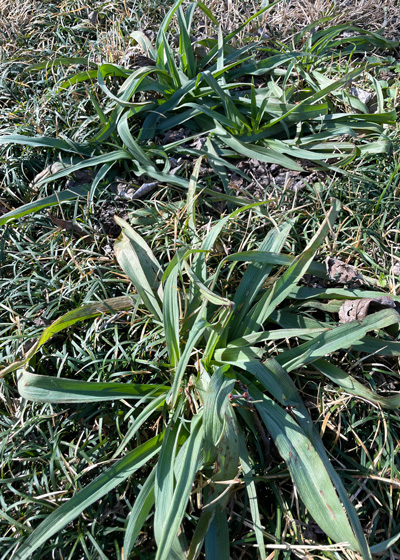
Answer: Obviously, if it has purple flowers it’s not going to be a grass. That would lead me to suggest a broadleafed weedkiller spray containing 2,4-D on a trial basis. However, it may grow from bulbs or other storage organs below ground, which means that it may take more than one spraying. A friend thought it might be squill. Here’s something I found written up about squill’s invasive nature. (A photo of it in flower would help identify it – better yet, take an actual flowering specimen to a Texas Master Certified Nursery Professional.)
QUESTION 3
WHAT COULD BE KILLING THE REDCEDAR TREES?
Question: Do you know what might be killing the redcedar trees in pastures in our area? I don’t see any insects. Beth W., North Zulch.
Answer: You would have seen bagworm bags hanging on them if they had been the culprits. They would have done their damage last summer and the bags would still be there.
Spider mites are active on conifers right now. I can show you several dozen plantings of other species of Juniperus other than your eastern redcedar junipers that are currently being killed by spider mites. This particular pest shows up much earlier in the growing season than the mites that attack our flower and vegetable crops like marigolds, violets, beans and tomatoes, among many others. Thump some of the suspect twigs over white paper. If you see extremely tiny paprika-colored specks starting to move around after a few seconds, those are the mites. General-purpose insecticides that are also labeled for mites would control them.
But the biggest cause of loss of redcedars that I’ve observed over the past eight months has been effects of last summer’s drought. Normally these plants are quite tolerant of dry times, but many were lost because conditions were so bad.
QUESTION 4
WILL THE RIVER ROCK HURT OUR RED OAK?
Question: I put river rock beneath our big red oak and then watered the ground through the rock. Did I put it on too thickly? I have landscaping cloth beneath the river rock. Is this all OK? Nancy S., Dallas.

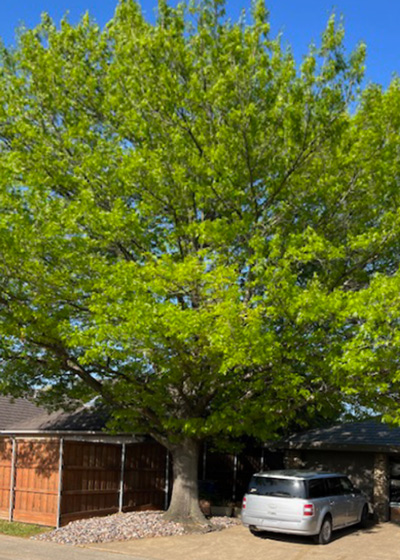
Answer: The river rock is just fine. It allows good movement of air and water into, and out of, the soil. I do notice in your dormant winter photo that you have a root starting to push up on the pavement. A crack is starting to develop and it will proceed rapidly as the root enlarges this year. You probably should have a certified arborist look at the setting to discuss your best options before you lose your driveway.
QUESTION 5
DO YOU HAVE RECOMMENDATIONS OR COMMENTS ON USE OF PRODIAMINE GRANULES ON A NORTH TEXAS LAWN?
Question: I see your standard suggestions for use of Dimension, Halts and Balan as pre-emergents. Do you have any recommendations or comments on the use of Prodiamine granules on a North Texas lawn? John R., Grapevine.
Answer: It is a well-respected product that is included in at least one leading brand of weed control remedies. It offers both pre- and post-emergent control. As long as you read and follow label directions carefully it will do a fine job for you. In all candor, the reason I have stuck with just the three in my commentaries is that people get totally befuddled by the concept of pre-emergent controls. It’s hocus-pocus to them to be putting a control out for something they can’t see. Dimension, Halts and Balan all operate on the same schedules and can all be described in the same terms. Prodiamine would simply add one more element of confusion into an already lengthy discussion. But in all clarity, it is a fine product.
QUESTION 6
IS THIS A GOOD PLACE FOR A BLOODGOOD JAPANESE MAPLE?
Question: Is the area beneath the canopy of this red oak a good place for a Bloodgood Japanese maple? It faces west, but it is very shaded when the canopy is full. I am concerned of what will happen if the power people butcher the red oak, leaving it in full sun. Michael G., Mansfield.
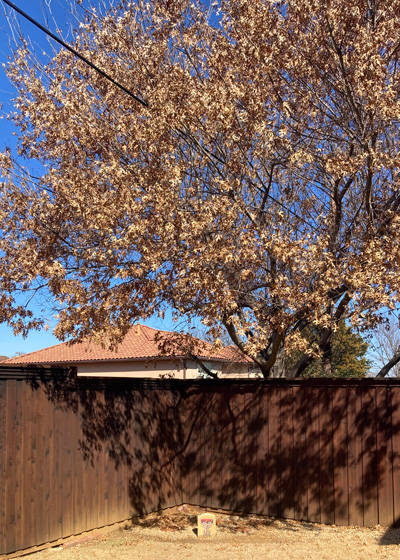
Answer: It doesn’t seem like the right place to me. Sun would still pour in from the west beneath the lower branches of the red oak. Bloodgoods also grow as tall as those lower branches, so it would be up in there competing. Yes, I do think the power company’s service people will be trimming that oak. It’s in a dreadful setting, so don’t blame the power people. They are responsible for keeping power in your neighborhood, not for doing slow, careful pruning of trees that should have been planted elsewhere in the landscape. But that’s not why we called this meeting. I’d suggest you plant a nice tree-form yaupon or shrubby Nellie R. Stevens holly there. Either would have dark green foliage all winter to contrast with the starkness of the red oak, plus it would have bright red berries – a better complement to the Red Raider Red of your marker than the Aggie Maroon of Bloodgood’s leaves.
QUESTION 7
WHAT SHOULD I DO WITH MY MOUNTAIN LAUREL?
Question: This began as a 1-gal. Texas mountain laurel. What, if anything, should I do to it now? It is so heavily branched. Patti H., Weston.
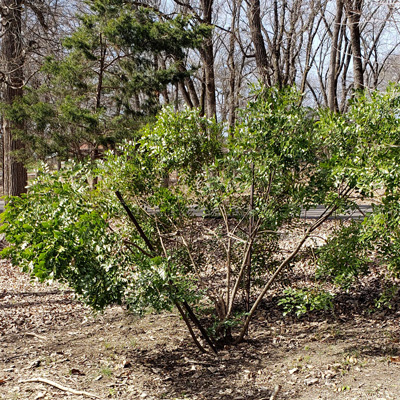
Answer: That’s a very good question. Unless I’m seeing it incorrectly, it looks like a main trunk broke or died in the center some time back? Or perhaps that’s just one of the many other trunks. And it looks like you have trunks tied together for support, perhaps two or three pairs of them. And maybe two metal stakes. Obviously, all of this is because the plant is splaying out from the weight of its outer branches. I would selectively and very carefully do twig removal along the outer branches to remove any twigs and small limbs that came out parallel to the ground (or hanging downward). Do this with hand shears and trim off just a couple at a time. Step back a few feet to see what impact their removal has had. If it’s good, trim off a couple more. Your goal eventually will be to have a shrub that looks like a Willowleaf holly in form and fullness. If you get any new shoots along the trunks and down near the ground, allow them to develop in the hopes that you can get the plant away from this weeping appearance. The entire transformation is likely to take two or three years.
Side note: Congratulations on getting it through the winter of 2021. Most mountain laurels in North Central Texas were either lost or severely damaged.
QUESTION 8
WHAT ARE THE NEGATIVE OUTCOMES OF TOPPING OAK TREES?
Question: I have heard about the negatives of topping crape myrtles. What about oak trees? Steve S., Gruene, Comal County.
Answer: Since you didn’t attach a photo, my mind ran wild. The first thing I thought of was the ice storm and the incredible damage it did to Central Texas live oaks a few weeks ago. If that’s what you’re talking about, if a Certified Arborist is doing the work, he or she will know how to do the best possible thing for each tree, each branch in each set of circumstances. It’s all about saving and restoring the trees. Live oaks have remarkable capabilities of recovering.
If, on the other hand, you’re talking about topping oaks just for some purpose of creating an unusual shape or “keeping them shorter,” I’m totally against it. There would be no justification, just as there is no justification for topping crape myrtles.
Should an oak get pruned for any reason, remember that every cut made to any species of oak (just to be safe) needs to be protected by application of pruning sealant immediately after the cut is made. That will greatly lessen the chance of spread of the oak wilt fungus. You are in a part of Texas where oak wilt is very active.
QUESTION 9
WHAT IS THIS STRANGE STUFF IN MY ST. AUGUSTINE? MY LAWN WAS DESTROYED LAST YEAR.
Question: My St. Augustine was destroyed last summer. I checked for grub worms but found none. I found a strange thing and was told it was sod webworms. My grass was always beautiful. The dead patches seem to be common in many lawns last year. What is this stuff I have coming up in the grass? Donna E., Fort Worth.
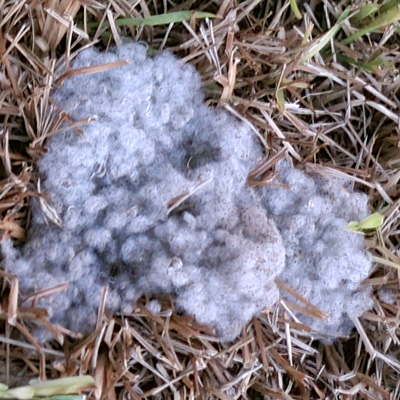
Answer: Every other call I took on the radio last summer seemed to be about St. Augustine. As I drove around my own home area (DFW) I saw hundreds of lawns in decline. Most of the people were convinced the much-publicized drought was to blame, but most failed to recognize that chinch bugs had moved in at the same time as the hot, dry weather. Chinch bugs feed on the grass in the hottest, sunniest parts of the lawn. The grass looks like it’s dry, but when you water, the lawn doesn’t spring back. Odds are very good that your St. Augustine either went down because of chinch bugs or drought.
As for this white, apparently fuzzy growth, I’m suspecting it’s a short-term fungal growth of no significance to the lawn. I do not remember ever seeing it. I would guess that there has been an animal that relieved itself in that spot and this mold grew on that organic matter after recent rains. Try washing it away with a hard stream of water.
I don’t think you’re going to see sod webworms.
This somewhat related story from across the Atlantic might be of interest:
https://gardening.stackexchange.com/questions/51675/what-are-these-white-fuzzy-growths-on-the-soil-of-my-lawn
